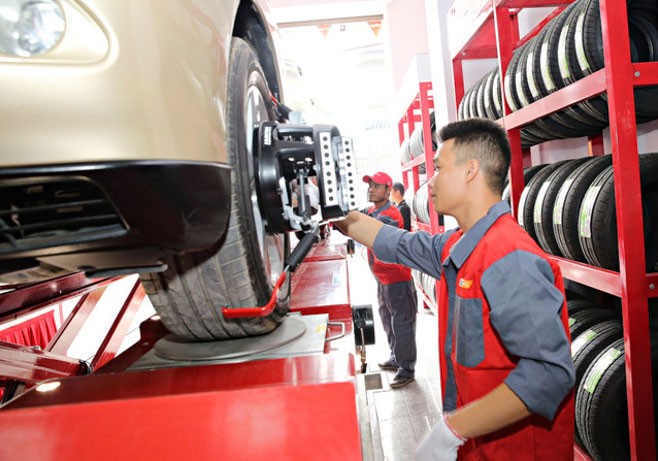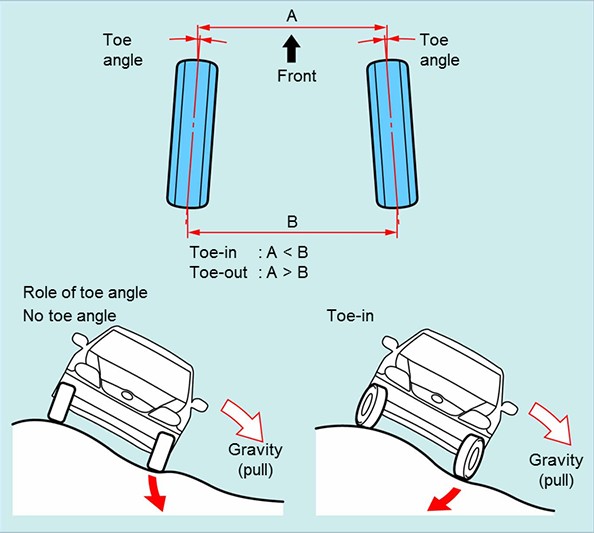Wheel alignment is crucial for your truck’s handling, tire wear, and overall lifespan. Many truck drivers, however, often overlook regular wheel alignment checks. What are the real benefits of truck wheel alignment? What are the costs and procedures? Let’s explore these details with Xe Tải Mỹ Đình in the article below.
1. Why is Truck Wheel Alignment Necessary?
During operation, trucks frequently encounter factors that negatively impact the suspension and steering systems. Hard impacts from potholes, road debris, or even traffic accidents can misalign the wheels. Additionally, worn suspension components or replacement parts can also lead to misalignment.
 Technician performing truck wheel alignment
Technician performing truck wheel alignment
Image illustrating a technician performing truck wheel alignment, ensuring proper wheel toe is achieved.
When truck wheel alignment is off, tires experience uneven pressure, leading to uneven and premature wear. This not only reduces tire lifespan but also affects vehicle handling, causing issues like pulling to one side, vibrations, and increased danger, especially at high speeds or when cornering. Therefore, regular truck wheel alignment checks are essential to ensure stable and safe vehicle operation, and to save on tire replacement costs.
2. What is Truck Wheel Toe?
Truck wheel toe is the distance between the inner edges of tires on the same axle, measured at the front and rear of the axle. The difference between these two measurements is the wheel toe. Toe is measured in millimeters (mm) or degrees (°).
 Diagram of truck wheel toe-in and toe-out
Diagram of truck wheel toe-in and toe-out
Image illustrating truck wheel toe, showing the distance difference between the front and rear tire edges.
There are three main types of truck wheel toe:
- Toe-in (Positive Toe): The distance between the front edges of the tires is smaller than the rear edges. The wheels point inwards towards each other.
- Toe-out (Negative Toe): The distance between the front edges of the tires is larger than the rear edges. The wheels point outwards away from each other.
- Zero Toe: The wheels are parallel to each other. This is the ideal toe setting for most trucks.
How to Recognize Misaligned Truck Wheel Toe
Truck drivers can observe several signs to identify potential wheel toe issues:
- Uneven Tire Wear: This is the most noticeable sign. If tires wear out quickly on the inner or outer edges, wheel toe misalignment is likely. Outer edge wear often indicates toe-in, while inner edge wear suggests toe-out.
- Steering Wheel is Off-Center: When driving straight, the steering wheel is not in the center position but is tilted to one side.
- Vehicle Pulls to One Side: The truck tends to drift to one side when the steering wheel is released on a straight road.
- Louder Tire Noise Than Usual: Due to uneven tire wear and suboptimal road contact, causing unpleasant noise.
3. Important Benefits of Truck Wheel Toe
Truck wheel toe plays a vital role in ensuring stable and safe vehicle operation. When a truck is moving, the suspension system and joints are constantly working, bearing load and impact from the road surface. Wheel toe is designed to compensate for these changes, helping maintain vehicle stability and minimize tire wear.
 Tie rod end and its effect on wheel alignment
Tie rod end and its effect on wheel alignment
Image illustrating a tie rod end and its influence on truck wheel alignment.
The tie rod end is a crucial component in the steering system, connecting parts of the suspension, chassis, and drivetrain. Changes in ride height during vehicle movement affect the tie rod end length, thereby influencing wheel toe. Correct truck wheel alignment ensures wheels operate at optimal angles, which helps to:
- Reduce Tire Wear: Proper toe ensures even tire contact with the road, minimizing uneven wear and extending tire life.
- Save Fuel: Evenly worn tires reduce rolling resistance, thus reducing fuel consumption.
- Enhance Handling: Accurate toe provides stable vehicle operation, smooth cornering, and reduces pulling or vibrations.
- Ensure Safety: A stable steering system helps drivers maintain better vehicle control, especially in emergency situations.
4. Consequences of Misaligned Truck Wheel Toe
Misaligned truck wheel toe can lead to serious consequences, affecting economic efficiency and driving safety:
- Rapid and Uneven Tire Wear: This is the most visible and costly consequence. Truck tires are expensive, and rapid wear increases operating costs.
- Reduced Lifespan of Suspension and Steering Systems: Misalignment puts stress on other suspension and steering components, causing them to degrade faster.
- Increased Fuel Consumption: Due to increased tire rolling resistance.
- Reduced Vehicle Control: Vehicle pulls, vibrates, and is difficult to corner, posing danger to the driver and other vehicles.
- Driver Fatigue: Constantly adjusting steering to keep the truck straight on long journeys causes fatigue and stress for drivers.
5. Truck Wheel Alignment Cost and Time
The cost of truck wheel alignment currently ranges from 500,000 VND to 1,200,000 VND, depending on the vehicle type, model year, and service center. Heavy-duty trucks, semi-trucks, or vehicles with complex suspension systems typically have higher alignment costs.
The truck wheel alignment process is quite quick, usually taking only about 30-60 minutes. However, the time may be longer if additional issues related to the suspension or steering system are discovered and need to be addressed.
Professional Truck Wheel Alignment Procedure
The truck wheel alignment procedure at professional service centers typically includes the following steps:
- General Inspection: Technicians inspect tire condition, suspension, and steering systems to identify the cause of misalignment.
- Wheel Toe Measurement: Specialized wheel alignment machines are used to determine the current toe settings of the vehicle.
- Reference Standard Specifications: Consult the truck manufacturer’s standard toe specifications.
- Toe Adjustment: Technicians adjust tie rod ends to bring wheel toe back to standard specifications.
- Re-Inspection: After adjustment, wheel toe is measured again to ensure settings meet standards.
- Test Drive and Verification: A test drive is performed to feel for changes and re-verify settings after alignment.
Regular Truck Wheel Alignment Schedule
To ensure your truck always operates in optimal condition, experts recommend regular wheel alignment checks according to the following schedule:
- Every 10,000 – 15,000 km: Or every 6 months of operation.
- When Replacing New Tires: To ensure new tires wear evenly and achieve maximum lifespan.
- After the Vehicle Experiences a Hard Impact: Or frequently travels on rough roads, potholes, or uneven surfaces.
- When Signs of Misalignment are Detected: Such as uneven tire wear, off-center steering wheel, vehicle pulling.
- When Performing Suspension or Steering System Maintenance:
Regular truck wheel alignment is a simple maintenance activity that provides many practical benefits. Be proactive in checking and aligning your truck’s wheels at reputable service centers like Xe Tải Mỹ Đình to ensure safety, save costs, and extend the lifespan of your truck.
See more:
- What is a car steering rack? What causes steering rack failure?
- The importance of steering alignment and tire balancing
- Regular car maintenance and replacement items
